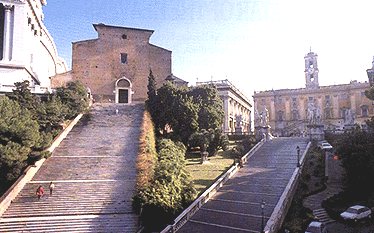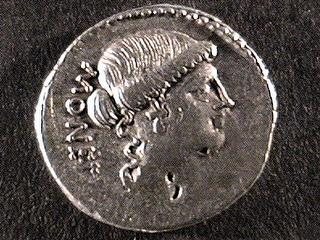
Moneta is the personification of prosperity
and finances. She is derived from an aspect of the Capitoline goddess Juno called
Juno Moneta where Moneta meant advisor, one who warns, or one who makes people
remember. Moneta was the Roman version of the Greek Titaness of memory, Mnemosyne,
who was the daughter of Uranus and Gaea and the abstract personification of
memory. She was also the mother of the Muses, each of whom presided over
one of the nine arts and sciences. Juno Moneta was an advisor to married woman.
How the temple of Juno on the Capitoline hill came to be associated with the
aspect of Juno Moneta is not clear and there are several explanations.
|
- The Romans asked Juno for advice in their war against King Pyrrhus of Epirus in 275 BC that resulted in his Pyrrhic victory (a victory gained at too great a cost). In appreciation of what was effectively a Roman victory, the Romans held a festival during a month named for Juno (our June), and erected a temple to her, naming it Moneta (as advisor to the Roman people). |
| - A second possibility comes from the siege of Rome in 390 BC. Most Romans had abandoned the city but the Roman senate several priests and some of its bravest citizens had taken refuge in the Citadel on the Capitoline Hill and refused to abandon this sacred site. One night the Gauls secretly climbed up the cliffs (which were thought to be unassailable) in an attempt to surprise the sleeping Romans. But when they approached the citadel the sacred geese of Juno started to honk and woke up the captain of the guard called Marcus Manlius who grabbed his weapons warned his comrades and saved the day by defeating the enemy. After this a shrine was built in honor of Juno Moneta , Juno the Warner because her sacred geese had "warned" of the attack. |
.

Church of Santa Maria in Aracoeli (on the left) built right over the site of the temple of Juno Moneta.
A new temple dedicated to Juno Moneta was built on the Capitoline hill over the old temple in 344 BC as the result of a vow taken by L. Furius Camillus during the war against the Auruncii. The first Roman mint was built next to this temple of Juno Moneta and called "ad Monetam" meaning by Moneta. Many of the coins struck here had the head of Juno Moneta on the obverse. These earlier coins showing her with this title will be referring to her as the goddess of marriage or advice and not a goddess of money. But eventually moneta came to be the word for both coin and mint, and eventually our word money. Later the word Juno was dropped and Moneta became the personification of finances and the prosperity that came with it.

An earlier Denarius of Moneta 46 BC (image from wildwinds)
Moneta is shown on coins robed holding scales (fairness in trade and use of money) and a cornucopia (the wealth that comes from this trade or money) sometimes with a stack of coins at her feet. Aequitas is also shown holding scales and cornucopia (not the stack of coins at her feet) so its very difficult to distinguish between the two with the legend usually being the only clue. The most common inscriptions are MONETA AVG (money of the emperor) and SACRA MONET AVGG ET CAESS NOSTR (Sacred money of our Augusti and Caesars).